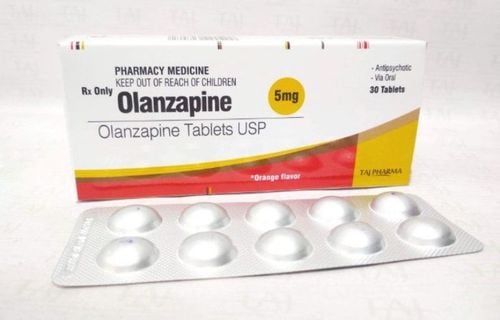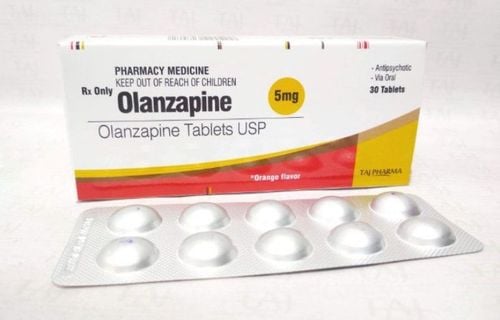This is an automatically translated article.
Olanzapine is one of the widely used antipsychotic active ingredients. Olanzapine product 5 mg is indicated for the treatment of schizophrenia, manic episodes or for the prevention of relapse of bipolar disorder.
1. What is brand-name drug Olanzapine?
Olanzapine 5 mg is a product of Savi Pharmaceutical Joint Stock Company, the main active ingredient is Olanzapine.
Many patients misunderstand the effects of this product, this is not just the sedative Olanzapine or the sleeping pill Olanzapine. This product is used in the treatment of schizophrenia, maintaining clinical improvement in patients who have responded to initial treatment with Olanzapine 5 mg. Olanzapine is also used to treat moderate to severe manic episodes or to prevent relapses in patients with bipolar disorder.
Olanzapine also has other brand names such as: Melyrozip 10, Olanpin, Oleanzrapitab 5...
2. Uses of Olanzapine 5 mg
Olanzapine 5 mg is indicated for the following conditions:
Treatment of schizophrenia, especially Olanzapine 5 mg is effective in maintaining clinical improvement in patients who have responded to treatment. first value; Treatment of moderate and severe manic episodes, especially if the manic episode has responded well to Olanzapine 5 mg, is also indicated for relapse prevention in patients with bipolar disorder.
3. Pharmacological characteristics of Olanzapine 5 mg
3.1. Pharmacodynamics Olanzapine is an antipsychotic active ingredient that acts on several receptor systems, including Serotonin receptors such as 5HT2A/2C, 5HT3, 5HT8, dopamine receptors such as D1, D2, D3, D4, D5, muscarine receptors from M1. to M5, α1-adrenergic receptors and H1 receptors of Histamine. Animal studies have shown that Olanzapine has 5HT (5-hydroxytryptamine) receptor antagonism, with dopamine and anticholinergic activity consistent with its ability to bind to receptors.
3.2. Pharmacokinetics Absorption: Olanzapine is well absorbed after oral administration, with peak plasma concentrations occurring within 5 to 8 hours. At the same time, food did not affect the absorption of Olanzapine 5 mg. Plasma concentrations of the drug are linear and dose proportional in studies with doses ranging from 1 to 20 mg.
Distribution: About 93% of Olanzapine is bound to plasma proteins at concentrations ranging from 7 to 1000 ng/ml, mainly to albumin and α1 - acid glycoprotein. Metabolism: Olanzapine is metabolised in the liver by conjugation and oxidation to the major metabolite, 10-N-glucuronide. In addition, the cytochrome P450 enzyme systems CYP1A2 and CYP2D6 are involved in the metabolism of Olanzapine 5 mg to N-desmethyl and 2-hydroxymethyl, however the in vivo activity of both is much lower than that of Olanzapine in animal studies. Elimination: The half-life of Olanzapine in healthy subjects varies with age and sex, averaging about 33 hours with a plasma clearance of about 26 l/hr.
4. Dosage of Olanzapine 5 mg
Recommended Olanzapine dose in adults:
Schizophrenia: Initial dose is 10 mg/day (2 Olanzapine 5 mg tablets); Manic phase: Initiate at 15 mg/day (3 Olanzapine 5 mg tablets) as monotherapy or 10 mg/day (2 Olanzapine 5 mg tablets) in combination therapy; Prophylaxis of recurrence of bipolar disorder: The recommended starting dose is 10 mg/day (2 Olanzapine 5 mg tablets). If the patient has been treated for a manic episode with Olanzapine, continue at the same dose when preventing recurrence of bipolar disorder. If a manic, depressive, or mixed episode occurs, treatment with olanzapine should be continued (the dose may be adjusted if necessary) in addition to other supportive therapies. Olanzapine doses for the treatment of bipolar disorder, manic episodes, or prevention of relapse of bipolar disorder are clinically adjustable. The use of higher-than-recommended Olanzapine dosages applies only after clinical evaluation has been conducted for not less than 24 hours. When deciding to discontinue Olanzapine, the physician should consider gradual dose reduction.
Dosage of Olanzapine 5 mg in some special subjects:
Patients with renal or hepatic impairment: The dose should be reduced in these subjects. Moderate hepatic impairment (cirrhosis, child-pugh class A or B) should be started at a dose of 5 mg (1 tablet of Olanzapine 5 mg ) and caution should be exercised when increasing the dose; Non-smokers versus smokers: There was no difference in the starting dose and usual therapeutic dose range of Olanzapine. Smoking may decrease the metabolism of olanzapine, so an increase in dose and close clinical monitoring may be considered; In the presence of more than one factor that slows the metabolism of Olanzapine (eg, sex, age, non-smoking, etc.), the physician should consider a lower-than-normal starting dose of Olanzapine and exercise caution when administering olanzapine. dose increase; Children: Olanzapine should not be used in children under 18 years of age; Elderly: No dose adjustment of Olanzapine is required, but a low dose (1 tablet of Olanzapine 5 mg/day) should be considered in people over 65 years of age. Olanzapine 5 mg overdose and management:
Olanzapine has no specific antidote, so poisoning cases require appropriate supportive treatment measures; In cases of acute poisoning, consideration should be given to establishing and maintaining airway clearance, ensuring adequate oxygen supply. Patients can be treated with activated charcoal, which reduces the bioavailability of oral olanzapine by 50-60%. Alternatively, gastric lavage may be considered (after intubation in a comatose patient); Hemodialysis cannot remove most of Olanzapine ; Olanzapine-induced hypotension and collapse should be treated with appropriate measures such as intravenous fluids or norepinephrine (do not use epinephrine, dopamine, or beta-agonists, as beta-receptor stimulation can more severe hypotension due to alpha receptor blockade by olanzapine).
5. Undesirable effects of the drug Olanzapine 5 mg
Common side effects of Olanzapine include:
Weight gain, increased cholesterol, glucose, blood triglycerides or increased urine glucose, increased appetite; Consciousness lethargy, dizziness, restlessness, parkinsonism, dyskinesia; Orthostatic hypotension; Hyperprolactinemia; Increased eosinophils, decreased neutrophils; Mild and transient anticholinergic effects such as constipation and dry mouth; Asymptomatic elevation of liver enzymes ALT, AST; Rash; Athritis; Erectile dysfunction in men or reduced sexual ability in both men and women; Asthenia, fatigue, edema, fever; Increased alkaline phosphatase, creatine phosphokinase, gamma glutamyltransferase and blood uric acid. Some rare undesirable effects when using Olanzapine 5 mg:
Hypersensitivity; Exacerbation or exacerbation of diabetes, sometimes combined with ketoacidosis or coma, even leading to death; Convulsions, dystonia or tardive dyskinesia; Forgetfulness or dysarthria; bradycardia, prolonged QT interval; Thrombosis, including pulmonary embolism and deep vein thrombosis; Epistaxis; Distention; Skin and teeth are sensitive to light, hair loss; Urinary incontinence, urinary retention; Amenorrhea, breast enlargement, increased milk secretion, gynecomastia in men; Total hyperbilirubinemia. In addition, Olanzapine 5 mg may cause some rare side effects as follows:
Thrombocytopenia; Hypothermia; Neuroleptic malignant syndrome, withdrawal symptoms; Ventricular tachycardia, ventricular fibrillation, sudden death; Pancreatitis; Hepatitis; Rhabdomyolysis; Prolonged erection.
6. Contraindications of Olanzapine 5 mg
Olanzapine 5 mg is contraindicated in the following cases:
People with a history of hypersensitivity to Olanzapine or any of the ingredients in Olanzapine 5 mg preparations; Patients at high risk for angle-closure glaucoma.
7. Some precautions when using Olanzapine 5 mg
Elderly people with dementia-related mental/behavioral disorders should use caution when administering Olanzapine 5 mg due to an increased risk of mortality, primarily from cardiovascular or infectious causes. Use of Olanzapine 5 mg in the treatment of dopamine agonist-associated psychosis in patients with parkinsonism is not recommended. Neuroleptic Malignant Syndrome (NMS) associated with antipsychotics is a serious and potentially fatal condition if not managed promptly. However, reports of NMS associated with Olanzapine are relatively rare. Manifestations include high fever, muscle stiffness, altered mental status, and autonomic instability. Patients should immediately discontinue use of all antipsychotics, including Olanzapine 5 mg, when signs and symptoms of NMS or unexplained high fever develop. Dyslipidemia occurred in patients treated with Olanzapine 5 mg in placebo-controlled clinical trials. Therefore, users of antipsychotic drugs such as Olanzapine 5 mg should have their blood lipids checked before taking the drug, 12 weeks and every 5 years thereafter. Liver enzymes such as ALT and AST are sometimes transient, asymptomatic, especially at the beginning of treatment with Olanzapine 5 mg. Therefore, patients should be carefully monitored if they have elevated ALT or AST, have symptoms of liver failure or have pre-existing impairment of liver function, and are taking hepatotoxic drugs. Patients who have been diagnosed with hepatitis should discontinue treatment with Olanzapine 5 mg. Acute manifestations such as diaphoresis, insomnia, tremor, anxiety, nausea or vomiting have been reported (although rare) with abrupt discontinuation of Olanzapine 5 mg. Olanzapine 5 mg acts primarily on the central nervous system, so caution should be exercised in combination with other drugs that also have CNS effects or in patients with alcohol abuse. Olanzapine 5 mg should be used with caution in patients with a history of seizures or with factors that lower the seizure threshold. Orthostatic hypotension was rare in the elderly during the clinical trials of Olanzapine 5 mg, making it important to have blood pressure measured periodically in patients over 65 years of age. Olanzapine 5 mg is not recommended for children under 18 years of age. Studies of the use of Olanzapine in children 13-17 years of age have shown adverse effects such as weight gain, changes in metabolic parameters, and increased blood levels of prolactin. Because Olanzapine 5 mg can cause drowsiness, care must be taken in driving or operating machinery. Pregnancy: There are no adequate and well-controlled studies in this population. Patients should tell their doctor if they become pregnant or plan to become pregnant while taking Olanzapine 5 mg. Neonates exposed to antipsychotics (including Olanzapine 5 mg) during the third trimester of pregnancy are at increased risk for adverse events including extrapyramidal syndrome and withdrawal symptoms with duration and severity. varying degrees of severity after birth. Lactation: A study in this subject showed that Olanzapine was excreted in human milk at concentrations approximately 1.8% of the dose. Therefore, the treatment of psychosis with Olanzapine is not recommended in this population.
8. Drug interactions of Olanzapine 5 mg with other drugs
Other drugs affecting Olanzapine 5 mg :
Diazepam : Concomitant use with Olanzapine 5 mg increases the risk of orthostatic hypotension ; Antacids (magnesium, aluminum), cimetidine: single dose does not affect the bioavailability of Olanzapine 5 mg orally. Activated charcoal: reduces the Cmax and AUC of Olanzapine 5 mg orally by about 60%, which may be an effective measure to manage Olanzapine 5 mg overdose. Fluvoxamine - CYP1A2 inhibitor: reduces the clearance of Olanzapine by 5 mg, so a dose reduction of Olanzapine should be considered when the patient is receiving fluvoxamine. CYP2D6 inhibitor - Fluoxetine: slightly increased Cmax (16%) and slightly decreased clearance (16%) of Olanzapine 5 mg; however, no dose adjustment was required in this case. Omeprazole and rifampin: increased clearance of Olanzapine 5 mg. Olanzapine 5 mg affects other drugs:
Drugs that act on the central nervous system: Olanzapine 5 mg acts on the central nervous system, therefore caution should be taken when combining Olanzapine 5 mg with other drugs that also act. to the central nervous system. Antihypertensives: Olanzapine may cause hypotension, enhancing the antihypertensive effect of antihypertensives. Levodopa and dopamine: Olanzapine 5 mg antagonizes levodopa and dopamine agonists; Diazepam: Olanzapine does not affect the pharmacokinetics of diazepam, however, the combination of Olanzapine and diazepam may increase the risk of orthostatic hypotension. Olanzapine is one of the most widely used antipsychotics. Olanzapine product 5 mg is indicated for the treatment of schizophrenia, manic episodes or for the prevention of relapse of bipolar disorder. To ensure the effectiveness of treatment, patients need to take the drug exactly as directed by the doctor or pharmacist.
Follow Vinmec International General Hospital website to get more health, nutrition and beauty information to protect the health of yourself and your loved ones in your family.
Please dial HOTLINE for more information or register for an appointment HERE. Download MyVinmec app to make appointments faster and to manage your bookings easily.













